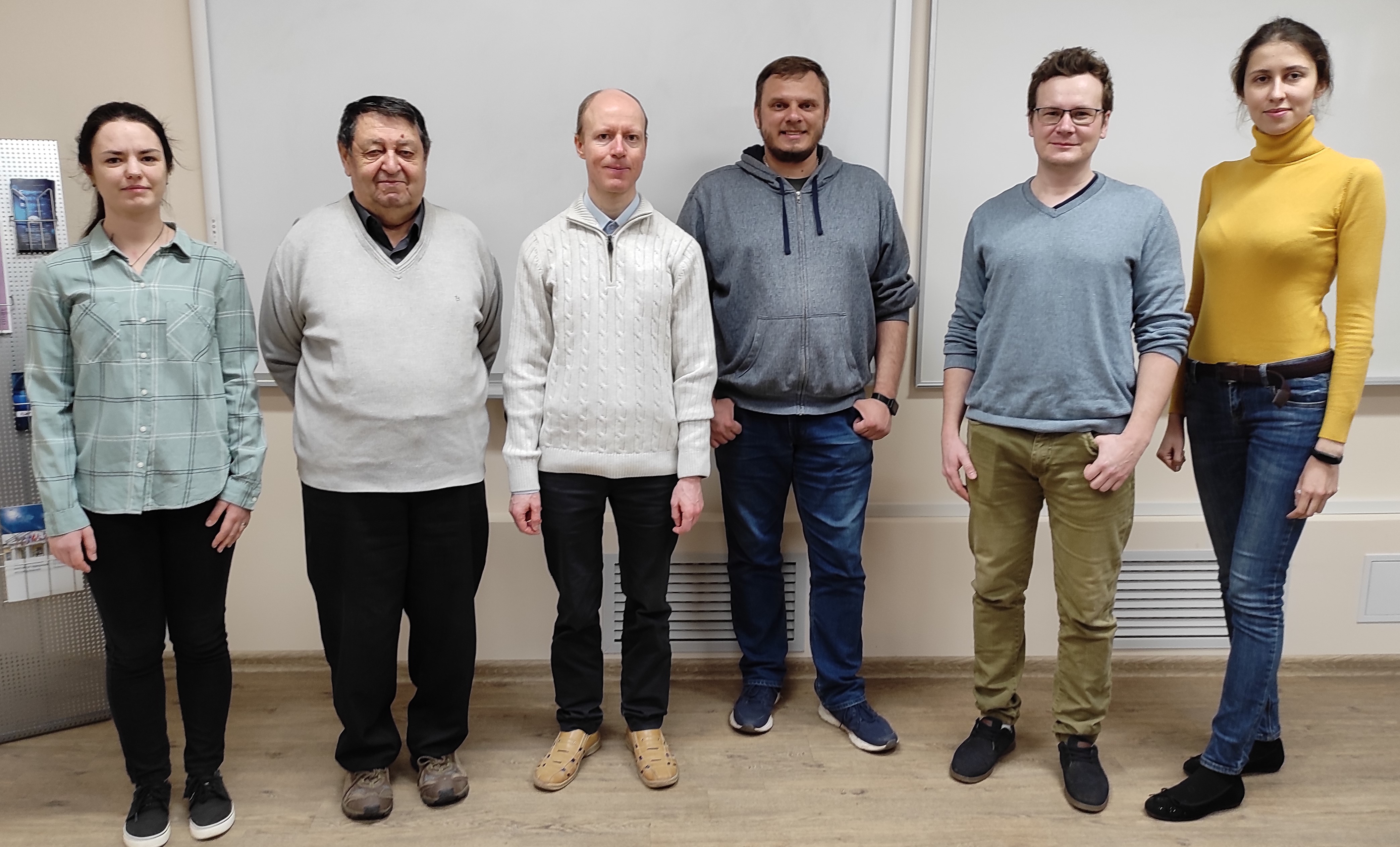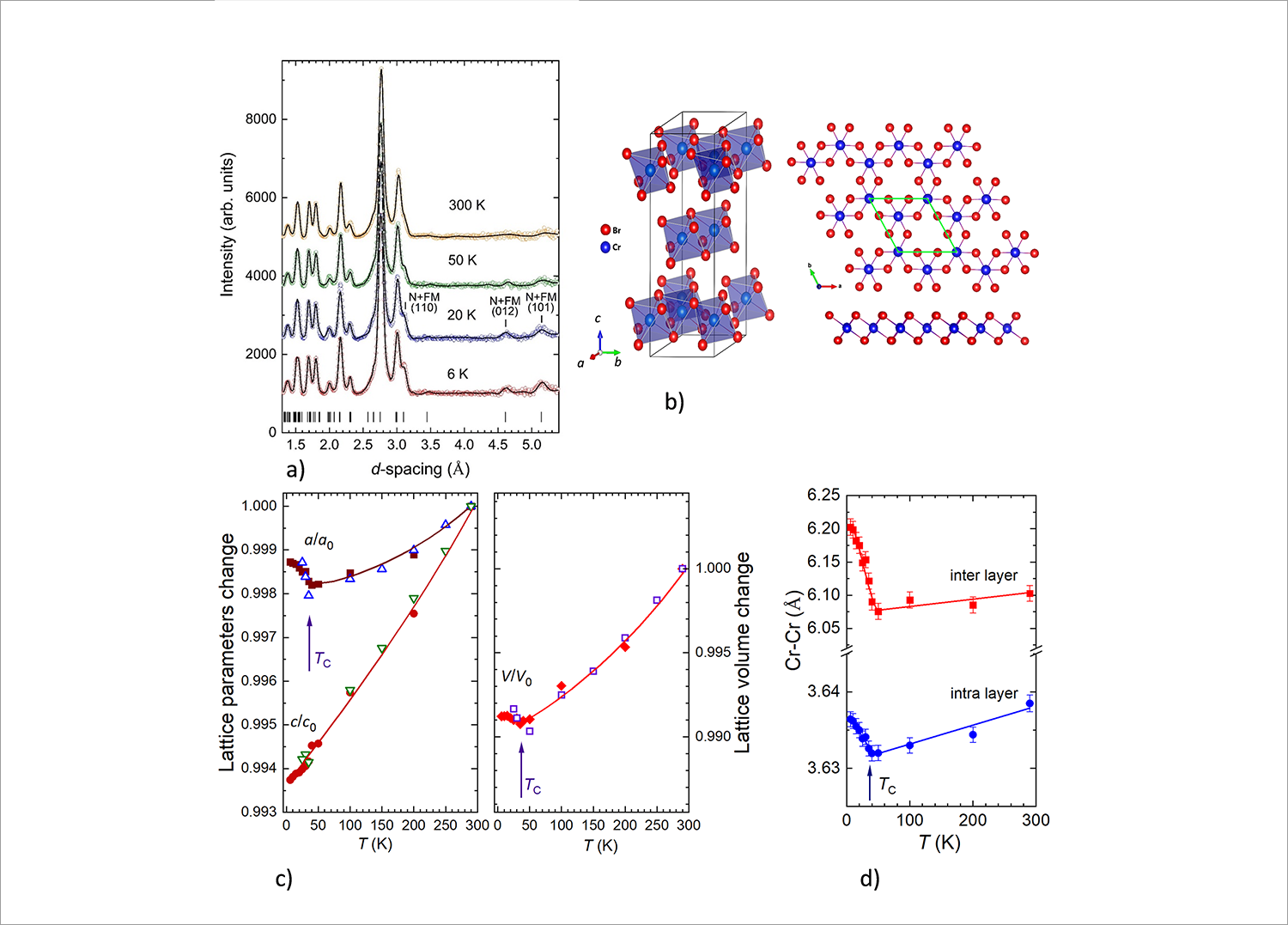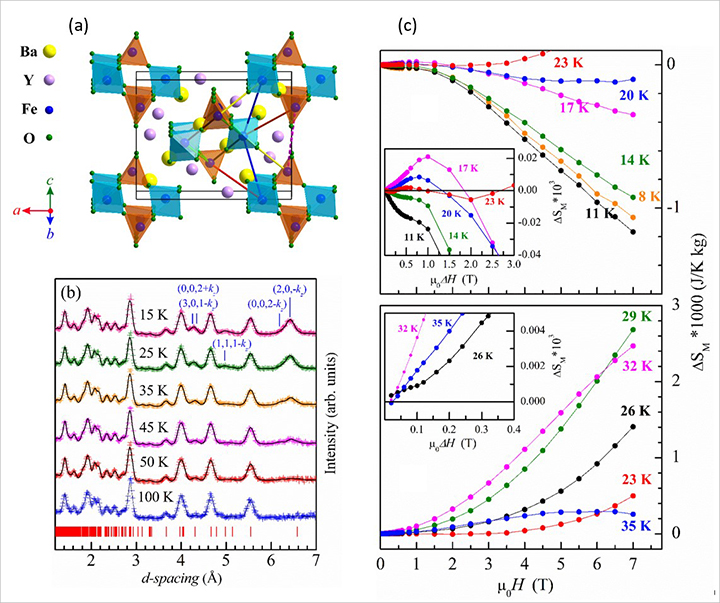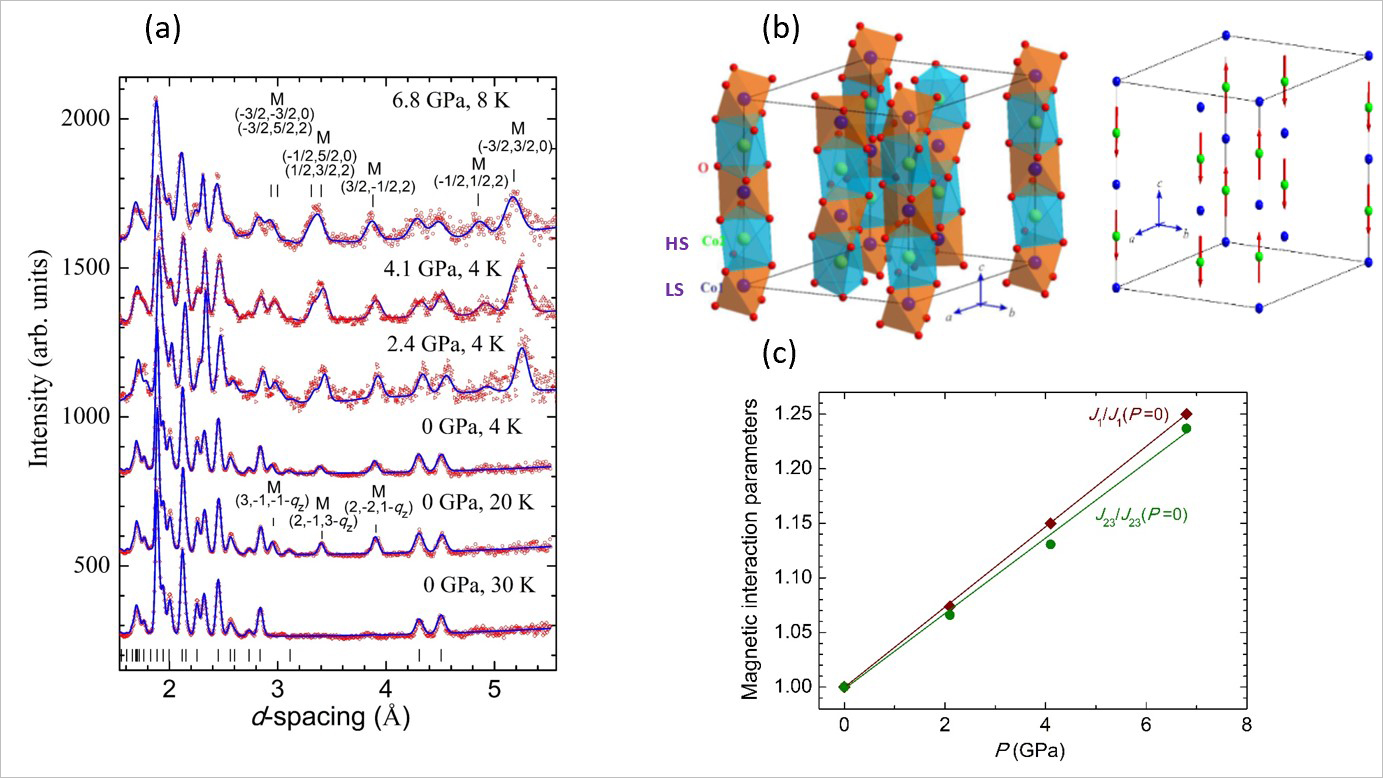New materials for spintronics and nanoelectronics being studied at JINR
News, 24 June 2022
Scientists of FLNP JINR in cooperation with scientific centres of Vietnam, carried out studies of unusual types of functional materials that belong to the so-called geometrically frustrated magnetic materials. These materials demonstrate not only new magnetic states with unusual physical properties, but also new physical phenomena can be observed in them when temperature and pressure change, for example, the appearance of a spin liquid state. The study of the properties of these materials is important not only for the development of modern concepts in the fields of condensed matter physics, but also for the development of an advanced generation of spintronics, nanoelectronics, recording and storage of information.
At the last JINR Prize contest for 2021, the articles cycle “New structural, magnetic, and physical phenomena in geometrically frustrated functional magnetic materials at variation of thermodynamic parameters” has been awarded the second prize in the category of the Experimental Physics Research. The authors of the cycle are D. P. Kozlenko, N. O. Golosova, S. E. Kichanov, E. V. Lukin, A.V. Rutkauskas, B. N. Savenko, O. N. Lis, N. M. Belozerova, Dang Ngoc Toan (Duy Tan University, Vietnam), and Le Hong Khiem (Institute of Physics VAST, Vietnam).
 Participants of research: Olga Lis, Boris Savenko, Denis Kozlenko, Sergey Kichanov, Evgeny Lukin, Nadezhda Belozerova
Participants of research: Olga Lis, Boris Savenko, Denis Kozlenko, Sergey Kichanov, Evgeny Lukin, Nadezhda Belozerova
Functional materials with geometrically frustrated magnetic lattices become the objects of the most actual research directions in modern condensed matter physics, materials science, chemistry. This is due to the fact that existence of several energetically equivalent spin configurations on the geometrically frustrated lattices leads to formation of novel magnetic states with unusual physical properties and new physical phenomena, among which are spin-liquid, spin-glass and spin-ice states, quantum critical phenomena, superconductivity, skyrmion states, new types of collective magnetic and lattice excitations, phase transitions, magnetoelectric phenomena, etc.
With an aim of systematic investigation of the features of the magnetic and spin states, several promising classes of functional magnetic materials like CrBr3, FePS3, BaYFeO4, Ca3Co2O6, Ca3Co2-xFexO6, Co3O4 with geometrically frustrated magnetic lattices were studies in a wide range of thermodynamic parameters (temperature 5 – 300 K and pressure 0 – 10 GPa) using the neutron diffraction method and complementary experimental methods, including X-ray diffraction, macroscopic magnetic properties measurements, Moessbauer and Raman spectroscopy.
The compounds CrBr3 и FePS3, which are representatives of a family of low-dimensional van der Waals layered magnetic materials with graphene-like magnetic lattice symmetry, demonstrate the existence of magnetic ordering down to the monolayer limit at sufficiently high temperatures. A rich variety of new physical phenomena have been discovered in these materials under variation of thermodynamic parameters (temperature and pressure), including the insulator-metal transition, spin crossover, and superconductivity. The studies of the structural and magnetic properties of the CrBr3 compound were performed at one of the JINR base facilities – the IBR–2 pulsed reactor, using the neutron diffraction method [1], and revealed the unusual effects. There is anomalous behavior of structural parameters in the temperature range of ferromagnetic ordering (ТС = 35 K), and a negative thermal expansion of the unit cell volume and quasi two-dimensional van der Waals layers in the temperature range T < TC (Fig. 1). It should be noted that negative thermal expansion is a relatively rare physical effect found only in a few classes of materials. The coefficient of linear thermal expansion of atomic layers in CrBr3 in the region T < Tc, αl = -1.6х10-5 K-1, is close to the corresponding value for graphene at low temperatures, which indicates a good compatibility of materials such as CrX3 and graphene in terms of prospects for development of heterostructures based on them. Its practical use can become an important step towards the development of an advanced generation of spintronics, nanoelectronics, recording and information storage devices.
 Fig. 1. a) Neutron diffraction patterns of CrBr3 measured at different temperatures and calculated profiles obtained by the Rietveld method. b) The schematic view of rhombohedral crystal structure of CrBr3 with symmetry R¯3. On the right van der Waals atomic layers are shown, top and side view. c) Temperature dependences of the lattice parameters and the unit cell volume of CrBr3, normalised to the corresponding values at room temperature. d) The temperature dependences of distances between Cr magnetic ions inside van der Waals layers (intra-layer) and between layers (inter-layer)
Fig. 1. a) Neutron diffraction patterns of CrBr3 measured at different temperatures and calculated profiles obtained by the Rietveld method. b) The schematic view of rhombohedral crystal structure of CrBr3 with symmetry R¯3. On the right van der Waals atomic layers are shown, top and side view. c) Temperature dependences of the lattice parameters and the unit cell volume of CrBr3, normalised to the corresponding values at room temperature. d) The temperature dependences of distances between Cr magnetic ions inside van der Waals layers (intra-layer) and between layers (inter-layer)
In the FePS3 compound, the existence of a new structural modification with a monoclinic crystal structure in the pressure range above P = 1 GPa (10000 atmospheres) was found. Structural rearrangement under high pressure leads to a change in the nature of the antiferromagnetic ordering from quasi two-dimensional to three-dimensional, which detected in a two times decrease of the magnetic lattice size [2].
The BaYFeO4 compound is a multiferroic material, in which the long–range magnetic order and ferroelectric polarisation coexist simultaneously. A reason for high interest in the study of multiferroics is the potential to control their electrical properties using a magnetic field and vice versa – magnetic properties control using an electric field. In BaYFeO4, spontaneous ferroelectric polarisation has a spin-induced nature associated with the symmetry of the magnetic states. The symmetry features of magnetically ordered states and the magnetic properties of this compound were studied in details (Fig. 2) using a combination of neutron diffraction, measurements of macroscopic magnetic properties, and Moessbauer spectroscopy [3]. The existence of modulated states with a long-range magnetic order, such as spin density waves and cycloids, as well as a magnetically disordered spin-glass phase, occurred below T* = 17 K, was revealed. It was shown that BaYFeO4 is a rare example of a multiferroic, where the disordered spin glass phase plays an important role in the formation of the magnetoelectric properties.
 Fig. 2. a) The view of orthorhombic crystal structure of BaYFeO4 with Pnma symmetry. b) The neutron diffraction patterns of BaYFeO4 measured at various temperatures, and corresponding profiles calculated by the Rietveld method. c) The dependence of the change in the magnetic entropy on the magnitude of the external magnetic field at different temperatures
Fig. 2. a) The view of orthorhombic crystal structure of BaYFeO4 with Pnma symmetry. b) The neutron diffraction patterns of BaYFeO4 measured at various temperatures, and corresponding profiles calculated by the Rietveld method. c) The dependence of the change in the magnetic entropy on the magnitude of the external magnetic field at different temperatures
One of the interesting representatives of complex cobalt oxides is the compound Ca3Co2O6. The presence of alternating octahedra CoO6 containing Co3+ ions in the low-spin state LS (S = 0) and CoO6 trigonal prisms containing Co3+ ions in the high-spin state HS (S = 2) leads to the formation of quasi-one-dimensional spin-chain magnetic structure on a frustrated magnetic triangular lattice. At normal pressure, an antiferromagnetic state of the spin-density wave type is formed in Ca3Co2O6, the periodicity of the magnetic lattice is incommensurate to the crystal lattice, the propagation vector is qsdw = (0, 0, 1.01), and the Neel temperature is TN = 25 K. Also, in the low temperature region, appearance of a disordered magnetic phase was observed with a characteristic magnetic correlation length of 128 Å. With a pressure increase above 2 GPa, a suppression of the incommensurate antiferromagnetic phase, and appearance of a new commensurate antiferromagnetic phase with a propagation vector qcaf = (0.5, -0.5, 1) and TNC = 26 K was observed, Fig. 3 [4]. A similar effect was found also at the substitution of cobalt with iron ions: with an increase in the concentration of iron in the Ca3Co2-xFexO6 compounds, the suppression of incommensurate magnetic states was found [5]. Within the framework of existing theoretical models, the changes in intra-chain and inter-chain magnetic interactions and their roles in the mechanisms of formation of magnetic ordered states and properties were analysed. The baric coefficient of the Néel temperature was calculated in the mean field approximation based on the one-dimensional Ising model, and a good agreement with the experimental value was obtained.
 Fig. 3. a) Neutron diffraction patterns of Ca3Co2O6 obtained at various temperatures and pressures, and calculated profiles obtained using the Rietveld method. b) The representation of rhombohedral crystal structure of Ca3Co2O6 with R3 ̅c symmetry, and the magnetic structure of the new high-pressure phase. c) Relative variation of intra-chain (J1) and inter-chain (J23) magnetic interactions as a function of pressure.
Fig. 3. a) Neutron diffraction patterns of Ca3Co2O6 obtained at various temperatures and pressures, and calculated profiles obtained using the Rietveld method. b) The representation of rhombohedral crystal structure of Ca3Co2O6 with R3 ̅c symmetry, and the magnetic structure of the new high-pressure phase. c) Relative variation of intra-chain (J1) and inter-chain (J23) magnetic interactions as a function of pressure.
In the Co3O4 spinel, an existence of spatial ordering of the Co3+ ions in the low-spin state LS (S = 0) in an octahedral oxygen environment and the Co2+ ions in the high-spin state HS (S = 3/2) in a tetrahedral oxygen environment leads to the formation of a frustrated diamond-type magnetic lattice, on which a unique state of a spiral spin-liquid state may appear. At ambient pressure, the formation of a complex magnetic state was observed, including the coexistence of a collinear antiferromagnetic phase and a magnetically disordered phase, presumably of the spiral spin-liquid type. With a pressure increase up to 9 GPa, the suppression of the disordered magnetic phase, and significant increase of the magnetic ordering temperature TN by 1.5 times, from 30 to 51 K, were observed. The important role of super-exchange interactions by means of two anions of type A-O-O-A in the formation of magnetic properties has been revealed [6].
References:
- D. P. Kozlenko, O. N. Lis, S. E. Kichanov, E. V. Lukin, N. M. Belozerova, B. N. Savenko “Spin induced negative thermal expansion and spin-phonon coupling in van der Waals material CrBr3”, npj Quantum materials 6: 19 (2021).
- M. J. Coak, D. M. Jarvis, H. Hamidov, A. R. Wildes, J. A. M. Paddison, C. Liu,
C. R. S. Haines, N. T. Dang, S. E. Kichanov, B. N. Savenko, S. Lee, M. Kratochvilova, S. Klotz, T. Hansen, D. P. Kozlenko, J.-G. Park, and S. S. Saxena “Emergent Magnetic Phases in Pressure-Tuned van der Waals Antiferromagnet FePS3”, Physical Review X 11, 011024 (2021). - N. T. Dang, D. P. Kozlenko, R. P. Madhogaria, D. T. Khan, L. T. P. Thao, S. E. Kichanov, B. N. Savenko, A. V. Rutkaukas, N. Tran, T. L. Phan, L. H. Khiem, T. A. Tran, and
M. H. Phan “Spin-glass induced ferroelectricity in BaYFeO4: A high magnetic field study”, Phys. Rev. Materials 5, 044407 (2021). - D. P. Kozlenko, N. T. Dang, N. O. Golosova, S. E. Kichanov, E. V. Lukin, P. J. Lampen Kelley, E. M. Clements, K. V. Glazyrin, S. H. Jabarov, T. L. Phan, B. N. Savenko,
H. Srikanth, M. H. Phan “Pressure-induced modifications of the magnetic order in the spin-chain compound Ca3Co2O6”, Physical Review B, 98, 134435 (2018). - R. Das, N. T. Dang, V. Kalappattil, R. P. Madhogaria, D. P. Kozlenko, S. E. Kichanov,
E. V. Lukin, A. V. Rutkaukas, T. P. T. Nguyen, L. T. P. Thao, N. S. Bingham, H. Srikanth, M. H. Phan “Unraveling the nature of Fe-doping mediated inter- and intra-chain interactions in Ca3Co2O6“, Journal of Alloys and Compounds, 851, 156897 (2021). - N. O. Golosova, D. P. Kozlenko, D. Nicheva, T. Petkova, S. E. Kichanov, E. V. Lukin, G. Avdeev, P. Petkov, B. N. Savenko “High pressure effects on the crystal and magnetic structures of Co3O4”, Journal of Magnetism and Magnetic Materials, 508, 165360 (2020).